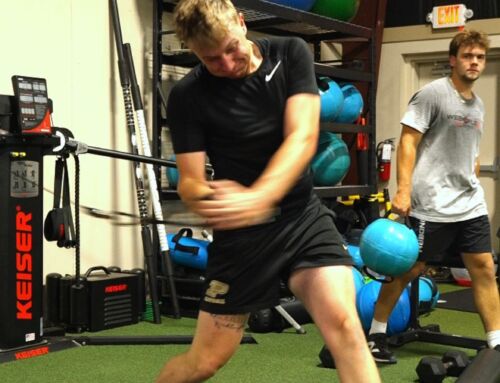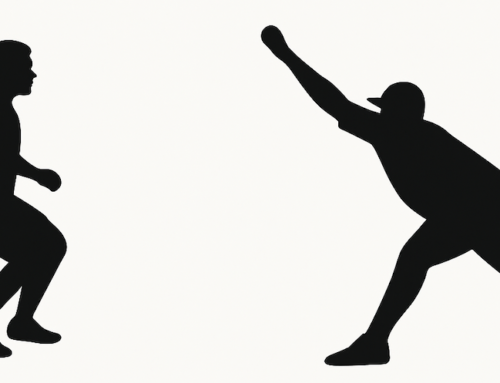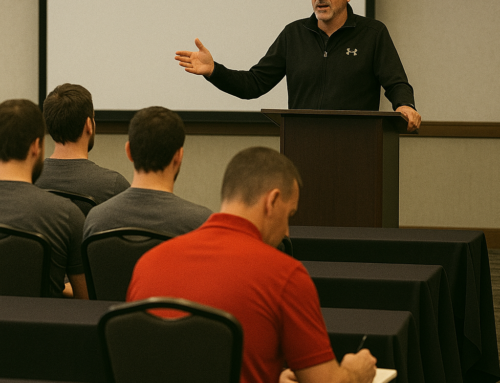
Anatomy Of Hip-To-Shoulder Separation
Unless you’ve been living in the baseball equivalent of a Himalayan monastery, you’ve heard pitching and hitting coaches avowing the importance of “hip-to-shoulder separation.”
I’m not exactly sure when it began, but sometime in the last several years, someone coined the term, and it spread like wildfire. According to advocates of this tenet, pitchers and hitters should rotate the pelvis while the torso remains closed for as long as possible. The resultant diagonal stretch through the trunk allows the athlete to take advantage of the elastic properties of the abdominals, and chest muscles to store and then unload energy to be transferred from the lower half to the arm or bat. The consensus seems to be that the two motions (pelvic rotation and torso rotation) should happen independently, which seems logical. But, based on the instruction I see, the inference is that when it comes to “hip-to-shoulder separation,” more is better.
The idea of hip-to-shoulder separation seems reasonable on the surface, and it does have some validity when applied appropriately. But, as per the norm in the baseball training industry, some of us may be exaggerating, misinterpreting, and/or corrupting the idea. Almost daily, new “separation” drills and exercises are crafted and published for the world to see.
Even football players have gotten involved.
Stability in the trunk is indeed essential to efficient movement as a pitcher and a hitter. Segmental rotation of the hips, then the shoulders can offer a productive option for high performance and injury risk reduction. But, as one might expect, more is not better. More is just … more. And, there is more than one way to skin this cat.
To explain, we need a short review of some muscle physiology concepts:
Length-Tension Relationships
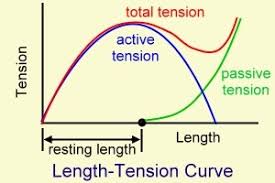
Muscles have both mechanical (contractile) and elastic properties. As discussed in my previous article, The Anatomy of Lead Leg Blocking, every muscle or group of muscles has a length at which it is the most strong. For example, the biceps muscle is weak when the elbow is fully extended, and it is weak when you completely bend it. Somewhere in between those two points, the biceps is at its optimal length.

Muscle Size Influences Length-Tension and Speed of Contraction
Recall from the previous article, a muscle’s size influences both force and the speed of contraction qualities. Longer muscles have a wide bandwidth of lengths at which they are optimally strong. They don’t produce or absorb as much force as shorter muscles, but they can create it quickly. Shorter muscles can generate a lot of force, but they can’t do it as rapidly as long muscles.
Muscle Shape Influences Length-Tension and Speed of Contraction
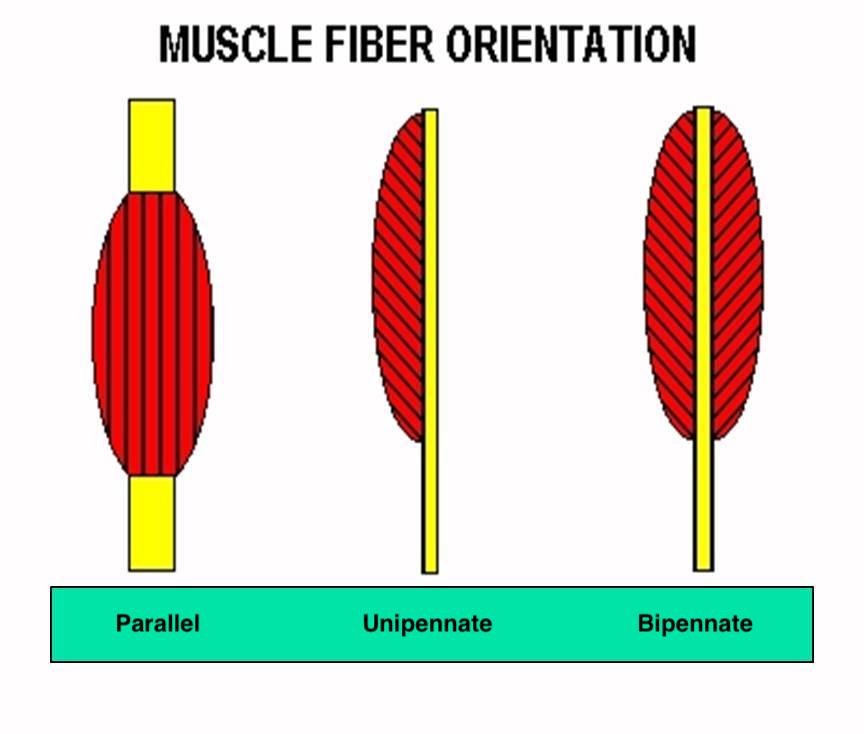
Length-force and length-speed qualities are also affected by the shape of a muscle — the orientation of the muscle’s fibers. Muscles with fibers in parallel to the line of pull of the muscle operate on the traditional length-force curve. However, muscles with fibers oriented obliquely to the line of pull (pennate muscles) appear optically long but behave more like shorter muscles. Pennate muscles can produce a great deal of force, but they don’t contract quickly, and they have a narrow bandwidth in which to find the optimal length.
If size and shape were the only variables involved, we could stop our discussion; however, there is more to the story.
Connective Tissue Influences Length-Tension and Speed of Contraction

The connective tissue surrounding and intermingled with a muscle also impacts the force production, speed of contraction, and bandwidth of optimal length. Fascia is everywhere. It surrounds the muscles, connects them, and weaves itself through every level of the muscle fascicle. This complex matrix of Have you ever noticed those little white strings, or marbling in a steak? Some of it is fat, but a lot of it is the fascia that has embedded itself into the muscle tissue. Fascia drills all the way down to the cellular level and is a vital part of the body’s process for self-organizing movement
Muscles with connection to a significant amount of fascia and other connective tissue, even if they appear optically long, function like short, thick muscles. They can produce an ample amount of force, but they can’t contract rapidly, and the bandwidth of optimal length is limited. It’s hard to visualize and appreciate the abundance of fascia, and it’s vital role in providing communication, coordination, and force sharing in the movement system. Fascia and its aponeuroses extensions are the structural core of biotensegrity, which is critical to self-organization and attractor stability. Biotensegrity is a model posited by orthopedic surgeon, Dr. Stephen M. Levin in which the bones are no longer viewed as braces or supportive struts. Levin explains, “There are only tension and compression elements in the body’s systems. There are no shears, bending moments or levers, just simple tension and compression, in a self organizing, hierarchical, load distributing, low energy consuming structure.”
In his book The Anatomy of Agility, Frans Bosch notes that muscles and the associated connective tissues have both mechanical and elastic properties. Bosch offers a modification of the Hill model of muscle contraction activity that explains the relationship of muscle size, shape and surrounding connective tissue beautifully.
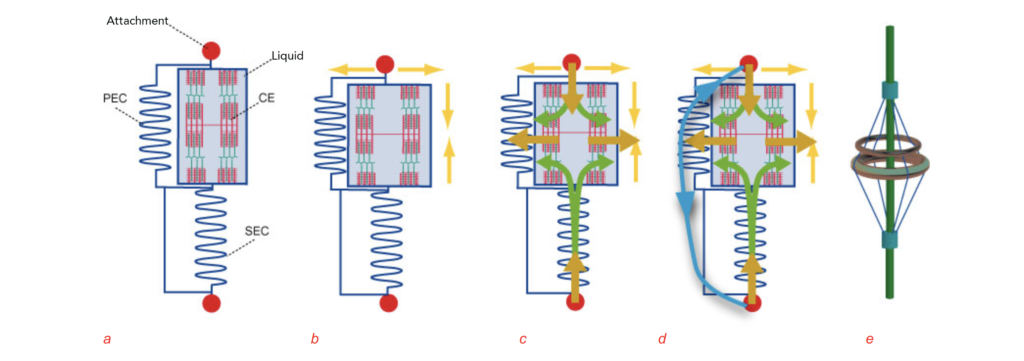
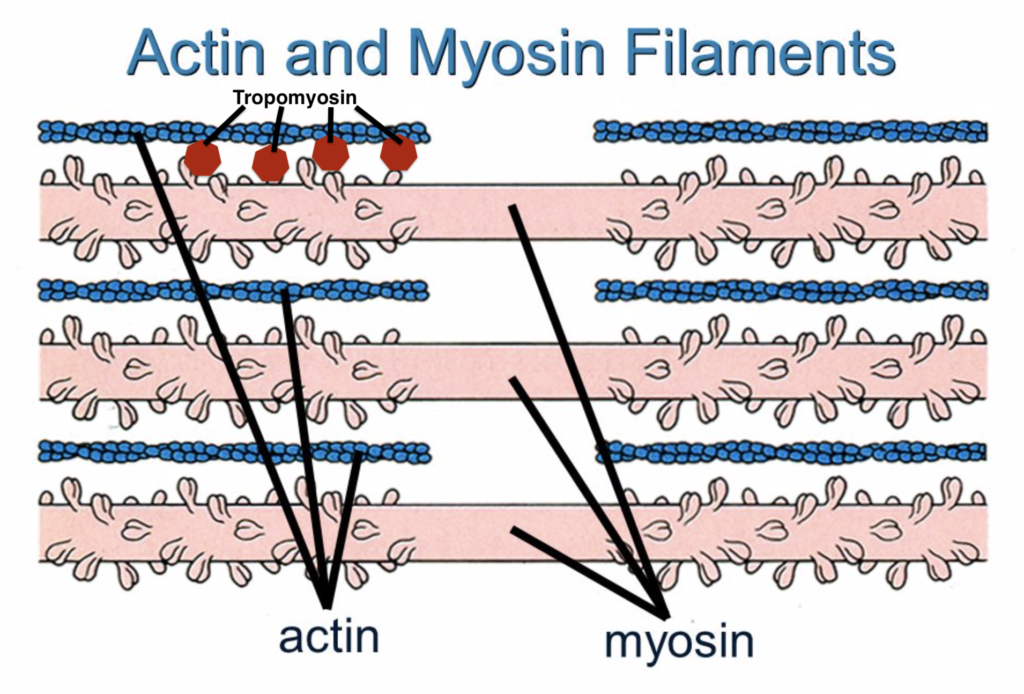
The Hill model is a three-part representation consisting of a contractile element (CE) and two non-linear elastic components. The contractile element (CE) is powered by the actin/myosin cross-bridges in the muscle which connect and slide and grab to create forceful contractions. The series element component (SEC) represents the tendon and the intrinsic elastic nature of the muscle itself. The parallel element component (PEC) includes connective tissue such as tendons, fascia and the aponeuroses surrounding and then blending into every level of the muscle.
Athletes in low intensity situations may be able to harness energy from the elastic components, however, when exposed to time pressure in high intensity activity activities, the window in which elastic properties are available is severely limited. Furthermore, the elasticity of a tendon is only valuable when its attached muscle is in an isometric state.
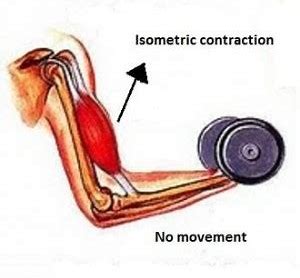
Since a muscle primarily composed of fluid, when isometric conditions occur, pressure from fluid compression causes the muscle to bulge radially or out to the sides (yellow line in the Bosch/Hill Model). Pressure from the fluid in the muscle sends energy through the interlaced aponeurosis and deep fascia. This energy is transmitted to the external fascia and passed along to other connective tissue. The flow of energy throughout this complex network of connective tissue links the muscles and encourages force sharing, which increases the athlete’s potential to create force or power. Fascial pressure signals subsequent to co-contraction also promotes inter-muscular communication and cooperation which is integral to coordinated strength and high-level performance. Finally, aponeuroses and fascial structures compressed by isometric muscle contraction wrap joints in a blanket of stability and help to attenuate stress, thus reducing injury risk. Well-timed, sequenced and synergized co-contraction amplifies an athlete’s ability to produce power, to achieve motor control, and to secure protection of of joints, ligaments and other vulnerable tissue.
Anatomy of The Trunk.
The rectus abdominus fibers appear to run in in the same direction as their lines of pull; however, the internal and external oblique fibers organize in perpendicular and diagonal patterns relative to their insertions.
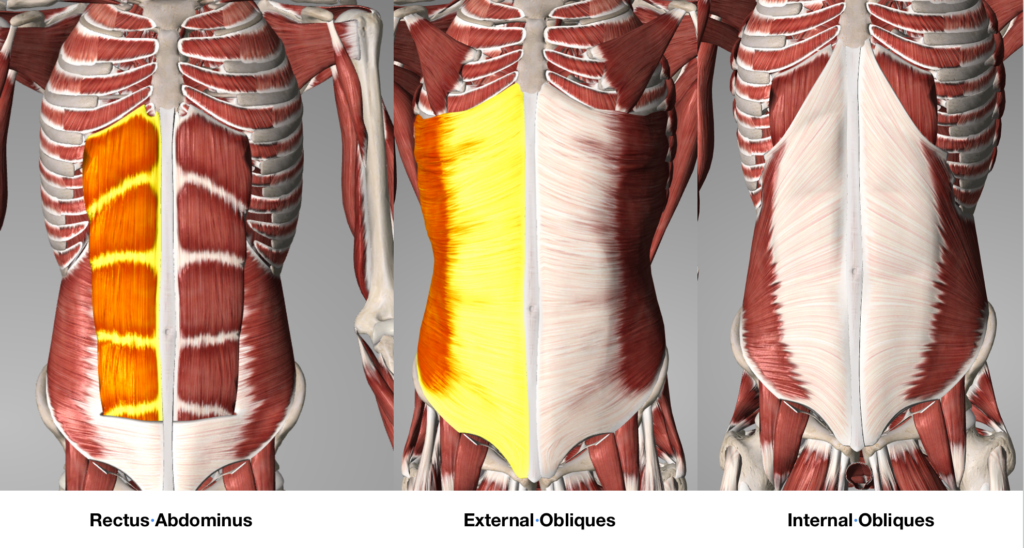
The abdominals also blend with a considerable amount of vulnerable connective tissue, such as the linea alba, the thoracolumbar fascia, and the inguinal ligament. This combination of active and passive structural connection means that while the abdominals appear optically long, in reality, they are functionally short. They can produce and absorb a great deal of force, but they can’t contract rapidly, and the bandwidth of optimal length is rather narrow.
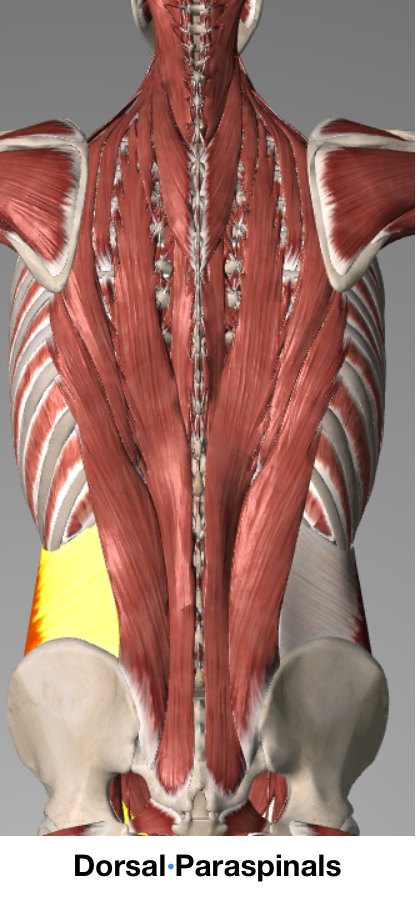
Similarly, the muscles on the back of the spine (dorsal paraspinals), intermingle with a substantial amount of passive connective tissue and feature muscle fibers oriented at oblique angles relative to their lines of pull. The dorsal muscles, therefore, appear optically long and thin, but functionally, they act more like short, thick muscles. Accordingly, they too have a narrow bandwidth of optimal length.
In pitching and hitting, the abdominals and paraspinals must gather and transfer massive amounts of force. To maximize the mechanical and elastic advantages of the trunk, and to reduce exposure to unattenuated stress, the athlete must achieve and maintain stability in the abdominals and the dorsal paraspinal muscles appropriately.
Two Types of Rotation:
In Anatomy of Agility, Bosh identifies two types of rotational movements commonly seen in the pelvis/torso complex, “real rotation” and “apparent rotation.”
Real Rotation
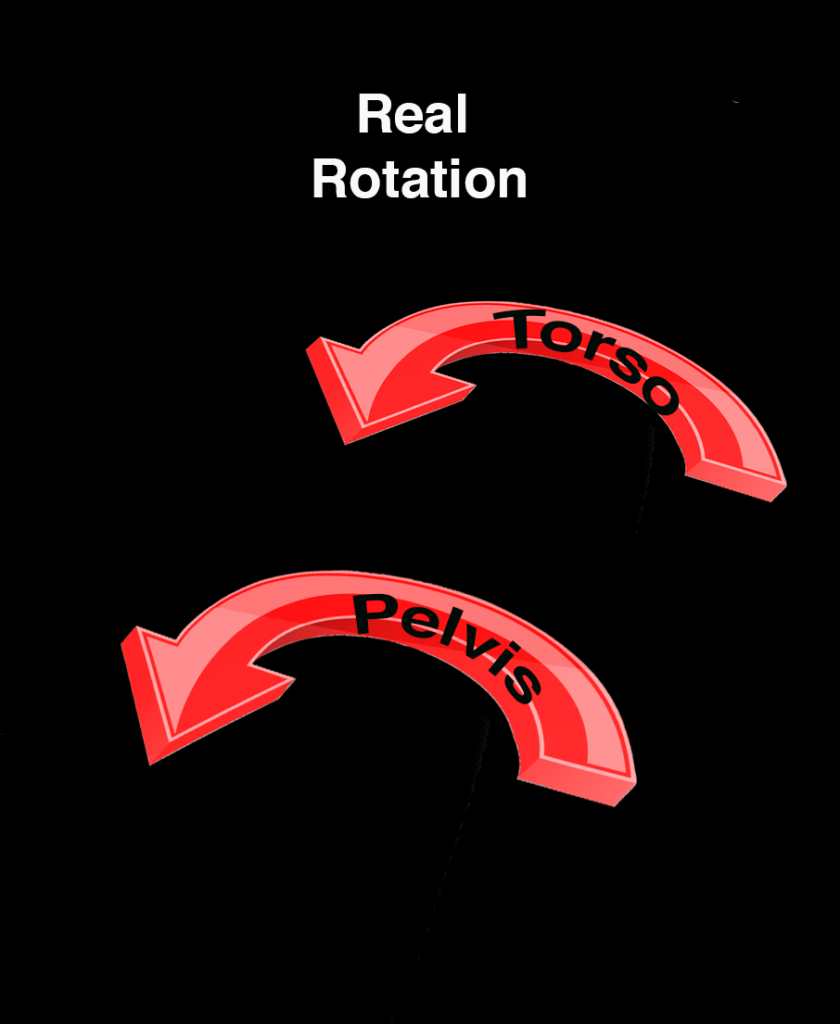
In real rotation, the pelvis and shoulders rotate in the same direction, but at different times. The pelvis rotates first, and the shoulders lag. In throwing and hitting, segmental “Real Rotation” elastically loads and then unloads the abdominals and their associated connective tissue. If synchronized well, separation of the hips and shoulders can capitalize on the full elastic properties of the trunk. But, when an athlete attempts to achieve extreme “hip-to-shoulder separation,” or if he poorly times “separation”, elastic loading of the abdominals can produce dangerously high peak forces. Under theses conditions, the athlete may subconsciously assume a protective body posture that lowers the elastic load (e.g., flexing or extending the spine).
Apparent (False) Rotation
Bosch notes that in rapid response situations (like a hitter reacting to a pitch), athletes may not have time to accomplish real rotation. In these cases, apparent rotation may present a reasonable movement solution. In apparent rotation, the pelvis and torso rotate simultaneously in opposite directions around a longitudinal axis. The result is a “net-zero” rotation.
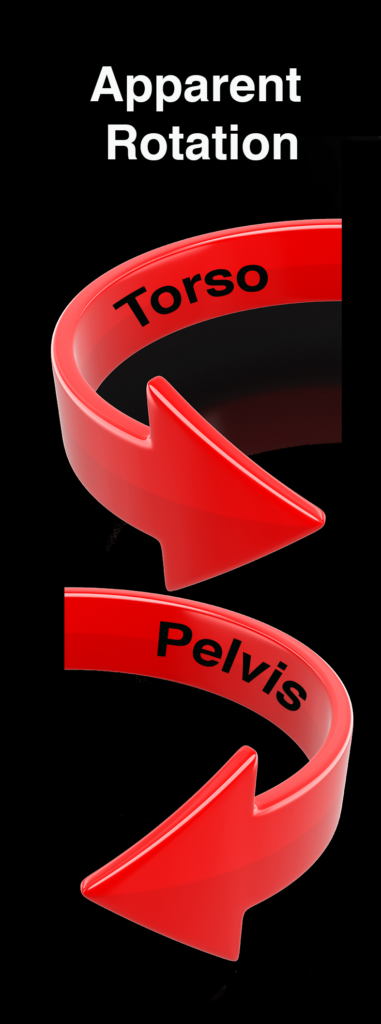
The problem with apparent or false rotation is that it does not always allow the release of the elastic energy of the abdominals as many “hip-to-shoulder separation” advocates proclaim. When a task exposes the athlete to time pressure, and/or unanticipated load (for example, when the hitter is off-plane, off-time, or out of balance), the athlete may not be able to harness the elastic properties of his trunk muscles. In this case, pretension through abdominal and dorsal paraspinal co-contraction may be necessary to provide the platform for removing muscle slack and maximizing power, control, and protection (PCP). If the athlete fails to accomplish a timely co-contraction, he may shift to a posture that compromises spinal stability, inhibits performance, or puts him at risk for injury. Understanding the necessity to manage phase shifts during rotation requires discussion of an important principle Frans Bosch presents in Anatomy of Agility.
Universal Movement Attractors
Remember that in our dynamical systems view of movement, attractors are characteristics that must be stable, and fluctuations are the parts that can be variable. In Anatomy of Agility, Bosch offers a list of universal movement attractors that apply to all forms of agility and sports performance. One universal attractor applies directly to our current discussion. Bosch calls it:
“Respect for The Sagittal Plane While Rotating”
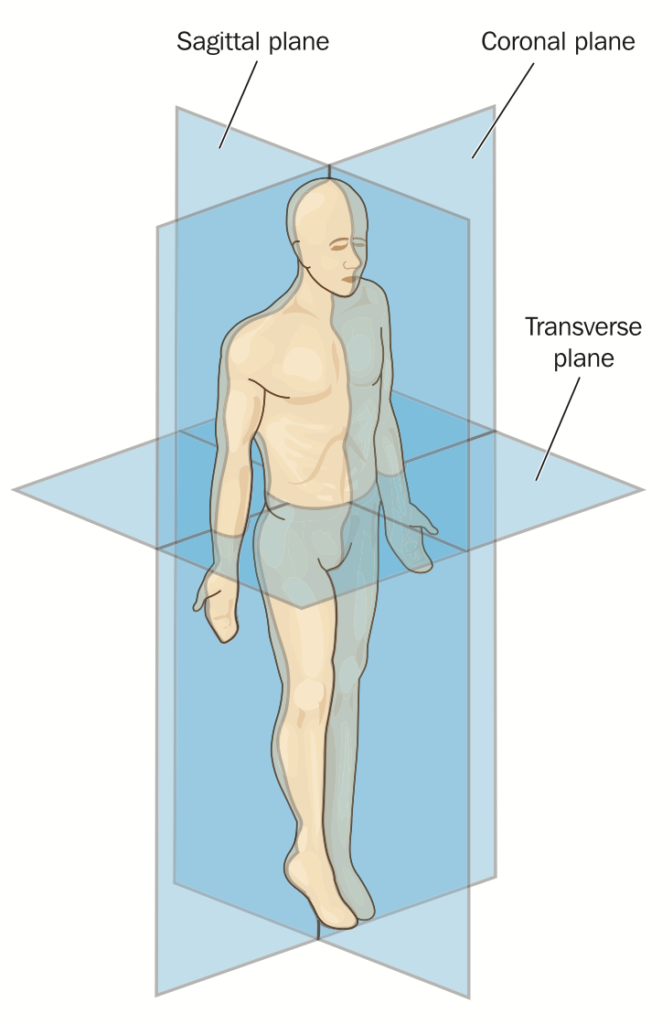
Under this precept, movement around a vertical axis (i.e., rotation of the hips and trunk in a pitch or a swing), “should not overflow into movements in the sagittal plane.” In other words, rotation, whether real or apparent, should not bleed into movements that either flex or extend the spine in the sagittal plane. Respecting the sagittal plane when rotating is essential for optimizing length-tension relationships and maximizing the elastic properties of the trunk.
Failure to respect the sagittal plane

We see this frequently in pitchers when poor stability in the back hip leads to directional issues. As the athlete projects himself toward his arm side on-deck circle, he must self-correct the problem. Commonly he does so with a premature hip or trunk rotation. If inefficient rotation leads to an abrupt postural change resulting lumbar extension, or flexion the athlete’s spine. In failing to “Respect The Sagittal Plane,” the pitcher compromises power and control and could increase his risk of injury.

Let me be clear here. Respecting the sagittal plane during rotation does not mean we violate another universal attractor, “Chest out while rotating.” Thoracic extension during rotation is an important component of trunk efficiency as it optimizes the length of the abdominals and chest muscles. But, perhaps more importantly, thoracic extension (chest out) during rotation for a pitcher allows the scapula to slide down the thoracic cage and toward the back pocket. This clears the way for achieving optimal external rotation of the shoulder (lay back). If the arm side scapula does not move toward the back pocket (scapular retraction and depression), the pitcher may not be able to adequately externally rotate the the throwing shoulder to a position of humeral head centration and optimal length of the shoulder musculature. Failure to respect sagittal plane during rotation occurs when the pitcher extends his lumbar spine, thus removing the abdominals and dorsal paraspinals from within their narrow bandwidth of acceptable length.
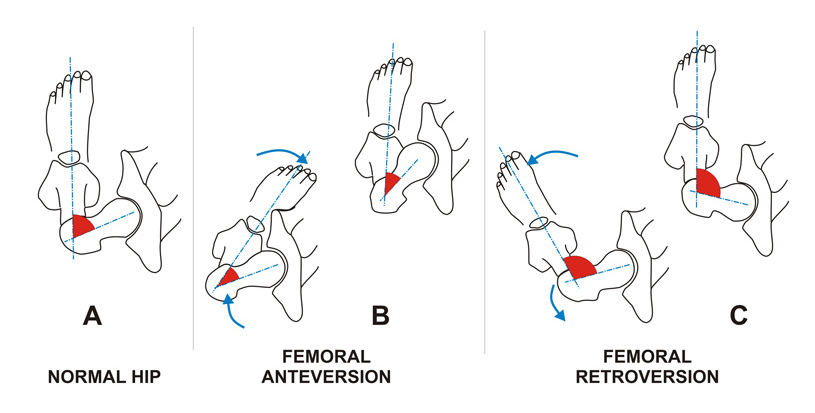
Another example of failure to respect the sagittal plane during rotation occurs commonly in pitchers with retroverted hips (sockets oriented facing outward and rearward). These pitchers tend to show a deficit in hip internal rotation. If retroversion of the hips is coupled with limited thoracic rotation and the pitcher’s first move projects him toward the arm side on deck circle, he will land with his lead leg across the midline. Since he lacks enough lead hip internal rotation range of motion to rotate around his front leg, the pitcher will be left with two options.

In the first option, the pitcher can rapidly and aggressively flex his back hip, pulling his knee toward the catcher. The problem with this choice is that in many cases, hip flexion during rotation causes the pelvis to tilt posteriorly. Posterior pelvic tilt shortens the abdominals to an insufficient length and the back rounds forward. As a consequence, the trunk passively flexes, the head bobs forward, violating another universal attractor (Head Remains Still). To further complicate matters, at ball release, the pitcher’s throwing arm often extends linearly toward the catcher, disrupting the pitcher’s deceleration pattern. The net result is that the hip flexion strategy dampens power, disrupts motor control, and increases risk of injury. For more on the dangers of a linear deceleration pattern, check out, https://floridabaseballarmory.com/blog/eccentric-biceps-is-the-devil-for-a-throwing-athlete/.
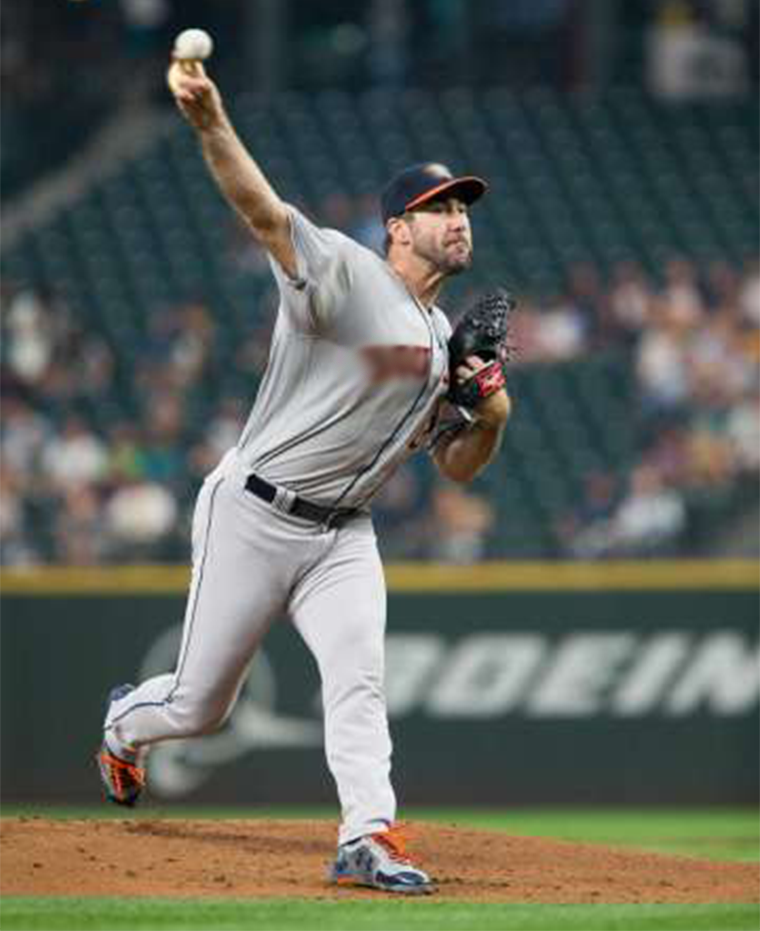
A second option for a retroverted hips, poor thoracic rotation, quad dominant pitcher who strides across his body is to go airborne with his back lag and vault over the front leg. When this happens, the trunk is free to rotate toward the glove side, but the pelvis automatically rotates in the opposite direction (rearward) in a classic apparent rotation. If this technique is selected, the abdominals and dorsal paraspinals can find themselves in a state of sub-optimal length. In such a situation, a well-timed co-contraction of the abdominals and dorsal paraspinals is critical and is likely the only chance the athlete has of stabilizing the spine to prevent a violation of the Respect The Sagittal Plane While Rotating attractor.
Note: In hitting, extending the thoracic spine and getting the rear chest out during rotation loads the back side scapula toward the back pocket. When the scap is loaded in this manner, the hands stay back during rotation. If the scap load (chest out) is released, the hands drift forward.

Bart Hanegraaff, the Director of Methodologies for the Pittsburgh Pirates, spoke about real rotation and apparent rotation at the 2019 Baseball Skill Acquisition Summit. With well-timed real rotation, the hips rotate, and the shoulder follow soon thereafter. If a hitter executes it well he maintains pelvic stability and optimal length of the abdominals throughout the swing. With enhanced pelvic and trunk stability, the hitter’s the swing becomes robust (resistant to perturbation or unpredictable forces), and resilient (resistant to phase shifts that disrupt movement efficiency and could present injury risk). Well-timed real rotation is the essence of what most coaches refer to as “hip-shoulder separation” can enhance power and adjustability, but is must be well coordinated and it may come with a cost in handling velocity. Depending on the quality and speed of the athlete’s movement, and his reaction time, time pressure from high velocity pitching may exceed the athlete’s ability to execute real rotation.

Since hitters are always under extreme time pressure, achieving real rotation may not always be possible. In many cases, apparent (false) rotation or the kickback move, may present a viable and productive solution — if it is properly executed. The athletes hardware (his physical structure) also plays an important role if the kickback maneuver is chosen. A hitter with retroverted hips and/or poor thoracic rotation mobility may not be able to achieve real rotation if he strides with his lead hip closed, or if he dives in toward home plate. Hitters with retroverted hips and limited thoracic rotation probably won’t be able to clear the lead hip to rotate the pelvis and the torso in the same direction. In this case, the kickback might be the preferred solution, but it also comes with strings attached.

For the athlete to pull off the kickback, timely co-contraction of the abdominals and paraspinal muscles is vital. Isometric co-contraction during apparent (false) rotation stabilizes the trunk and prevents it from “overflowing into the sagittal plane.” For example, extension in the lower back during rotation can lead to injuries such as lumbar stress fractures.
When a hitter is off-time, off-plane, or off-balance, the abdominals and paraspinals can be exposed to extreme, unpredictable forces. In this landscape of chaos, control of the pelvis and trunk is critical. Real rotation (hips, then shoulders) makes maintaining optimal abdominal/paraspinal length, and respecting the sagittal is reasonably easy to achieve and can offers adjustability in timing. When the abdominals are at optimal length, the hitter can hold the energy in what Bobby Tewksbary calls one of the “cogs of adjustability.” However, if the hitter corrupts the movement with an unnatural over-rotation of the hips, extreme stretching of the abdominals may rob the athlete of power and adjustability. If shear forces are not controlled health and safety may be compromised.
According to Bosch, in agility-related tasks, apparent (false) rotation is a movement option usually deployed when time pressure eliminates the choice of real rotation. In the Dak Prescott video above, the quarterback is rehearsing an apparent or “false” rotation. This strategy may indeed be useful in an emergency situation (e.g. if a rushing defender is bearing down on him and time and space are limited). However, if Prescott's offensive line maintains a clean pocket and he spots a receiver streaking 50 yards downfield on a skinny post, you can be the house that he'll step up and choose a true rotation to delivery the pass.
Applying that logic to baseball hitting, the kickback swing could be a valuable stratagem to defend against the extreme time pressure and chaos presented by high-level pitching. However, false rotation prohibits the athlete from achieving optimal length in the trunk musculature. To overcome this challenge timely co-contraction of the abdominals and dorsal paraspinals can provide a robust platform that prevents unstable trunk flexion or extension, thus allowing compliance with the “respect the sagittal plane” attractor. In the presence of unpredictable forces, or time pressure, failure to achieve an appropriate co-contraction could lead to suboptimal performance or increased risk of injury.

Encouraging Self-Organization of Solutions
Hitting and pitching begin as low intensity movements, but they rapidly phase shift into high-intensity states that expose the athlete’s trunk to massive, unpredictable forces. Due to the nature of the skill, the force and sensory information in hitting is obviously much more variable than on the pitching side. Still, in both tasks, the primary training goal should be to provide an environment that encourages the athlete to explore unstable conditions while finding and synchronizing the co-contractions necessary to optimize power, coordination, and protection. For example, if a pitcher with retroverted hips and limited thoracic mobility strides across his body, training experiences that promote hip hinging and a controlled ride can toward home plate should improve his direction. Better direction often eliminates downstream compensations
Once the movement is sufficiently stable, we should create training experiences that allow the athlete to explore abdominal and paraspinal co-contraction options in a multitude of otherwise unstable trunk positions and postures. This is especially important for hitters who use the kickback technique. Since co-contraction is so critical to kick-back stability, we should design training plans that encourage self-organization of co-contractions. These concepts should be infused into every facet of training.
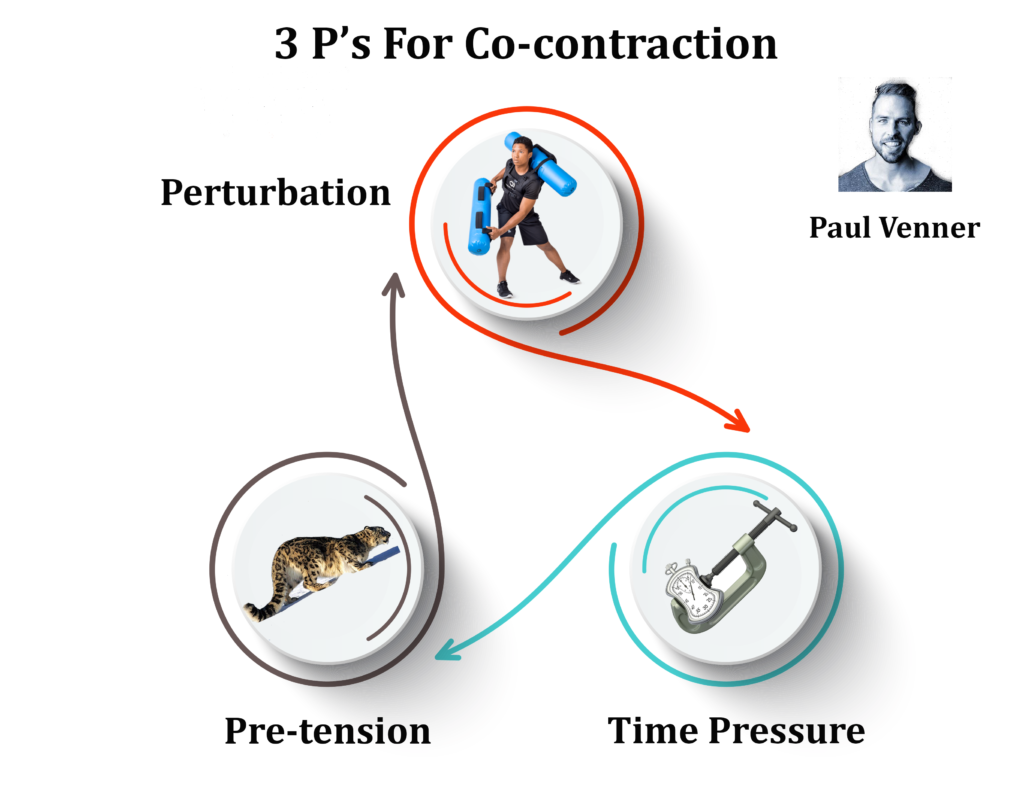
Dutch Baseball SCC, Paul Venner suggests we can encourage the exploration and discovery of co-contraction in 3 primary ways: 1) with pretension (manually removing slack with isometric co-contraction), 2) variable/unpredictable loads, and 3) time pressure. When the body is exposed to unpredictable forces or when it is stressed with time pressure, it reverts to its reflex of co-contraction. If you’ve every held a squirming baby, caught a big fish, or ridden a roller coaster, you’ve experienced co-contraction. When perform a trap bar dead lift or stand up from a chair the load is predictable and there is no time pressure. These activities don’t elicit co-contractions. However, when you’re running and the body senses you’re about to sprain your ankle, you co-contract. If you’ve ever survived a car wreck, you can bet your last vertebra you co-contracted. Co-contraction amplifies the body’s ability to produce Power, Control, and Protection (PCP).
Finding, timing, and synchronizing co-contractions throughout the kinetic chain to allow for rapid movement adjustments that are the essence of athleticism
SAVAGE Training — Specific Adaptation thru Variability And Goal-directed Experiences — immerses the
Our SAVAGE Pitching Coaches Certification Course (available at floridabaseballarmory.com/coach) empowers SAVAGE Certified coaches with the knowledge and tools necessary to develop athleticism specifically transferrable to high level performance on the mound. Over this transformational 12 hour video expedition, we’ll share a learning experience that will revolutionize your ability to impact your players. When you become SAVAGE Certified, you’ll get a 100 page workbook, written assessment and programming templates and over 300 videos to make immediate implementation as easy and natural as driving your car. During the course, we’ll show you every detail of how the car works. After the course, you’ll get all the videos, plans and forms you need to drive the car yourself, and we’ll always be just a phone call or email away to make sure you get it right.
Check it out at floridabaseballarmory.com/coach, or call us at 866-787-4533.
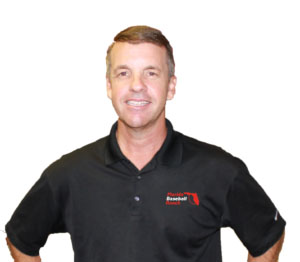
Randy Sullivan, MPT, CSCS CEO, Florida Baseball ARMory


